What are the signs of metabolic bone disease or MBD in bearded dragons?
As a pet owner, you always try to give your beardie all the best but raising a beardie is not easy at all, and improper care can lead to serious health problems. And one of them is Metabolic bone disease or mbd which can be painful and dangerous to bearded dragons. Therefore, having a profound understanding of the causes and signs of mbd in bearded dragons can allow you to know how to treat and prevent mbd in bearded dragons.
In this article, we would like to explain how to detect, treat, and prevent MBD.
Related Posts:
- Humidity Level for Beardie Eggs
- Best Plants for Beardie
- What Can Beardies Live With
- Why Is My Beardie’s Beard Black?
- Beardie Sleeping in a Water Dish
- Why Does My Beardie Stare at Me?
What Is Metabolic Bone Disease in Bearded Dragons?
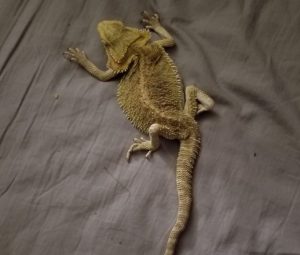
Maybe you are wondering what Metabolic Bone Disease in Bearded Dragons is.
Actually, this is just a relative umbrella term for one of several commonly found conditions seen in 2-year-old or younger beardies.
MBD in bearded dragons frequently results from a range of nutrient issues such as a lack of calcium and/or Vitamin D3 or phosphorous.
Especially, too little (hypocalcemia) or too much (hypercalcemia) calcium can have a negative impact on both the growth and the strength of a bearded dragon’s bones.
For example, a bearded dragon’s bones can be brittle and prone to fractures.
Also, MBD in bearded dragons can even make beardies deformed. Besides, limbs that curl up or drag along as they move, which make beardies uncomfortable and painful.
Therefore, it’s would be better if you can recognize the signs of mbd in bearded dragons. And you should know how to treat mbd.
https://www.youtube.com/watch?v=2sbVH3pWU7g
What Causes Metabolic Bone Disease in Bearded Dragons?
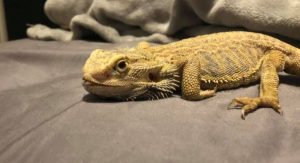
1. Too Much Or Too Little Calcium
The first culprit for MBD is related to calcium which helps to keep their bones healthy and strong.
Also, a calcium-rich diet allows beardies to produce Vitamin D3 which is responsible for not only bone health, but muscle health, and much more.
In the wild, beardies can get the right amount of calcium from a variety of plant and animal sources to keep the bones of young beardies growing properly.
However, regarding beardies in captivity, to provide your beardie a proper balance of dietary calcium requires you to combine proper diet with proper supplementation.
This is such a matter to most pet owners.
And if your beardie does not get enough calcium, which can lead to MBD.
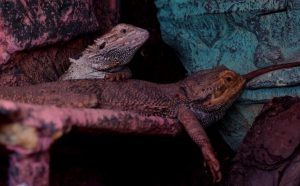
One common mistake that most pet owners can make is giving their beardies far too much calcium in the form of high calcium foods along with overdoses of calcium supplements in an attempt to provide enough calcium for optimal health, which would be counterproductive and lead to MBD.
There are some cases that reptile owners use the wrong type of calcium supplement, which can prevent beardies from getting enough calcium.
For example, powdered supplements, especially powdered dietary calcium, are very difficult for reptiles to absorb.
Therefore, using a much more easily digestible form of calcium is highly recommended.
We recommend:
- Fluker’S Repta Calcium
- Zoo Med Reptile Calcium Without Vitamin D3, 8-Ounce
- Zilla Calcium Supplement Reptile Food Spray
- Fluker’s Reptile Calcium Supplement Without Vitamin D3
2. Improper Diet
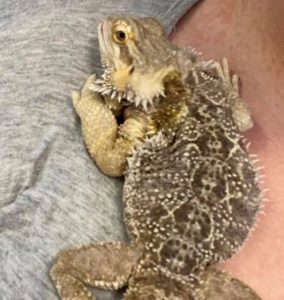
A healthy and balanced diet plays an essential role in the beardies’ development.
However, preparing such a diet is a matter, and there are some common mistakes that pet owners can make, which can lead to mbd.
It is undeniable that beardies need calcium to keep their bones healthy and strong.
Therefore, a calcium-rich diet is recommended as it allows the bearded dragon to produce Vitamin D3, which is very important for bone health, muscle health, and so on.
However, there are some kinds of food, especially high oxalate food and high phosphorous food that you should consider when giving to your beardies.
Regarding foods rich in oxalate, they can make the calcium undigestable as oxalate prevents the absorption of calcium by binding to it before it is absorbed by your beardie.
There are some examples of this kind of food such as kale, spinach, carrots, collards, and chards, and make sure that you shouldn’t include them as a daily staple in your dragon’s diet.
However, don’t make it wrong as you can feed your beardie these foods occasionally and remember to use other types of low oxalate, high calcium foods.
Another substance that can prevent the absorption of calcium can lead to mbd is phosphorus.
Therefore, you had better avoid giving high phosphorus foods to our bearded dragons such as bananas or some kinds of beans.
In short, if you notice some signs of mbd in bearded dragons, you should immediately check your daily diet and try to avoid these foods mentioned as soon as possible.
Other options that you can consider are turnip greens, collard greens, and vegetables like squash or green beans.
Related Posts:
- Can Beardies Eat Pears?
- Can Beardies Eat Rosemary?
- Do Beardies Eat Brussels Sprouts?
- Can Beardies Eat Peas?
- Can Beardies Eat Squash?
3. Low Temperatures
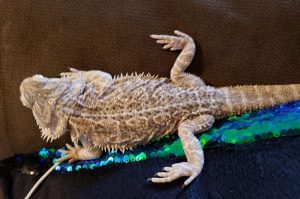
The reason why a basking spot that is not enough can be the culprit for mbd in bearded dragons is that bearded dragon relies on the heat in order to fully digest their food, which allows the bearded dragon to absorb minerals and vitamins… like calcium.
If the basking spot is too cool, which means your bearded dragon is more likely not to digest its food, he won’t be able to benefit much from the calcium in their diet.
Therefore, one of the ways of treating mbd is to give your bearded dragon a basking spot at proper temperatures, especially from 95 to 100 degrees Fahrenheit.
4. Lack of UVB
Lack of UVB is the main culprit for mbd as UVB plays an essential role in helping bearded dragon to convert vitamin D into vitamin D3 when absorbed through the skin.
Also, UVB helps to promote a healthy metabolism for reptiles of all ages and allocate vitamin D3 to the skeleton system, which is essential for bone health.
However, bearded dragon, in captivity, find it impossible to get enough UVB rays even if you place the tank near a window as UVB waves cannot pass through the glass.
Therefore, a high-quality UVB bulb, especially a ReptiSun UVB bulb, is completely important for beardies to get ample UVB rays.
It is recommended to buy high-quality lights and replace them every 6 months.
Make sure that you set them on timers so they are on for 12 hours every day.
What Are Signs of Metabolic Bone Disease in Bearded Dragons?
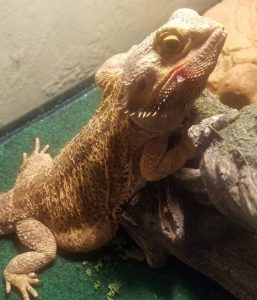
Before coming to how to treat mbd, we should have a look at signs of metabolic bone disease in bearded dragons. Moreover, you should know the underlying cause and have proper solutions.
However, these symptoms can also be signs of other health problems.
– Tremors or an involuntary shaking of the limbs, front or rear.
– Rubber Jaw/Softening of Facial Structure
– Weakness and lethargy.
– Stunted growth.
– Swollen rear legs and/or limb paralysis.
– Bone fractures, severely curled limbs, and inability to move.
As you can see, your beardie has to suffer from bad and painful experiences. Especially, they get MBD.
Therefore, if you notice any signs of mbd in bearded dragons, it’s imperative that you seek treatment for them immediately. Besides, you should take him to a reptile vet for testing for MBD.
How to Treat Metabolic Bone Disease in Bearded Dragons?
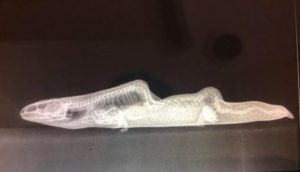
Maybe you are wondering how to treat mbd but don’t worry as most cases of MBD are treatable. Below are some steps that you could take to tackle this problem.
You suspect that your beardie has MBD with some of these signs mentioned before. And the best way is to make an appointment to see a reptile vet immediately.
The vet will perform some tests such as blood work, X-rays, and so on to find out health problems and prescribe your medication to give them.
One thing you shouldn’t do is curing mbd in your beardie yourself.
Looking for advice or solutions on some of the beardie forums as they are not effective.
One thing you should do for them is to make sure their diet, tank temperatures. Moreover, exposure to UVB is proper.
How to Prevent Metabolic Bone Disease in Bearded Dragons?
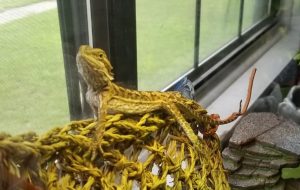
1. Diet
Regarding the diet for beardies with MDB, you had better feed your beardie organic baby food in the form of pureed chicken, squash, or pumpkin.
It includes foods that are high in calcium include squashes, mustard greens, dandelions, and papaya with a little calcium powder with Vitamin D3. This makes sure that he will get an adequate supply of calcium before and during any treatments.
And, make sure that no foods high in oxalate or phosphorous should be given. Also, you may be recommended to give your pet supplements in the form of calcium injections or oral medication.
However, while the oral medication is found to have a low absorption rate. The other is highly recommended but make sure you will not overdose it by asking the vet for help.
Read more:
2. Temperatures
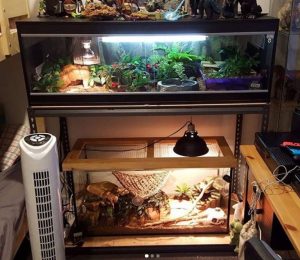
Another solution for treating mbd is adjusting the tank temperatures with a hot side (basking spot) and a cool side in the tank so that your beardie will have a consistent source of heat to properly digest his food.
Regarding adult beardies, the temperatures for the basking spot and the cool side should be between 100 and 105 degrees Fahrenheit and around 80 to 85 degrees Fahrenheit respectively.
Baby beardies need a little more heat from 105 to 110 degrees Fahrenheit. Also, it is advisable to keep your beardie’s tank a little bit warmer at night to boost his immune system.
To heat the tank, a Ceramic Heat Emitter (CHE) like this one here is recommended to instead of the tank heaters (UTH) because they are more likely to short out and burn your beardies, which sometimes leads to severe burns or even death.
The period of time of heat is also important so just keep it on timers.
It is highly recommended to have 12 hours on and 12 hours off.
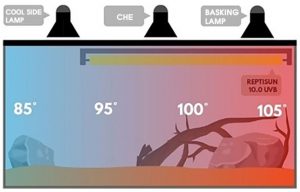
3. UVB
Proper UVB exposure will allow your dragon to utilize the calcium he or she takes in.
Therefore, in case your beardie doesn’t get enough UVB rays and have mbd, you should immediately address this issue.
Firstly, you should wonder you are using the right kind of UVB bulb to offer enough UVB to cover their entire tank or not.
In specific, long tube UVBS lights, especially Zoo Med Reptisun T5 HO 10.0 UVB, are highly recommended as they are good at dispersing UVB over a larger area.
Make sure that you keep your UVB bulbs directly overhead of your beardie with nothing in between them, like a screen lid, and the bulb is only about 6 to 8 inches away from your beardie when he is on the highest part of his basking spot.
One important thing is to install new bulbs every 6 months as the UVB output of these bulbs degrades over time.
4. Room to Move
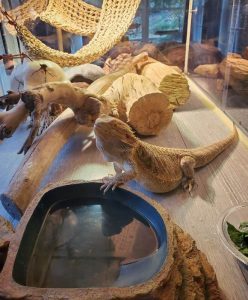
A vivarium providing enough room for your beardie to move around and do some physical exercises can lower the chance of mbd in bearded dragons.
You can checklist of beardie accessories to have many ideas for this: https://thepettime.com/best-bearded-dragon-accessories/
Conclusion
What are the signs of metabolic bone disease or MBD in bearded dragons?
Although MBD is a dangerous disease. And you can easily treat and prevent it if you can realize some signs of mbd in bearded dragons, and take immediate steps. I hope that through this article, you will have more knowledge and be fully aware of the importance of good husbandry practices, proper diets, the right temperatures, and enough UVB exposure, along with giving your bearded dragon calcium and vitamins in an attempt to prevent your beloved bearded dragon from Metabolic Bone Disease.
Key points for spotting MBD in bearded dragons:
Metabolic Bone Disease (MBD) is a common and serious health condition in bearded dragons, particularly if their dietary and environmental needs aren’t met. MBD results from a calcium and phosphorus imbalance, and it can lead to weakened bones, deformities, and severe health complications. Here are the key signs to watch for if you suspect MBD in your bearded dragon:
1. Difficulty Walking:
- Bearded dragons with MBD may struggle to walk properly due to weak or deformed limbs.
- Their legs may appear bowed or crooked.
2. Tremors and Shakiness:
- Muscle tremors, spasms, or shaking can be an early sign of MBD.
- These symptoms are often noticeable, especially during movement.
3. Soft and Swollen Jaws:
- MBD can affect the bones in the jaw, making them soft and swollen.
- This condition can lead to difficulty eating or even a lack of appetite.
4. Lethargy and Weakness:
- Bearded dragons suffering from MBD may become lethargic, lacking their usual energy and enthusiasm.
- Weakness can make it difficult for them to engage in normal activities.
5. Bumps or Lumps on the Body:
- Swellings, bumps, or unusual growths on the body, particularly around the limbs and spine, can indicate MBD.
- These deformities are often due to weakened bones.
6. Reduced Appetite:
- Bearded dragons with MBD may lose their appetite or have difficulty eating due to jaw and bone problems.
- Weight loss can result from this reduced food intake.
7. Fractures and Bone Deformities:
- MBD can lead to increased susceptibility to bone fractures.
- Deformities in the limbs or spine may become more pronounced over time.
8. Soft, Rubbery Lower Jaw:
- An easily flexible or rubbery lower jaw, known as “rubber jaw,” is a classic sign of advanced MBD.
- This condition severely impacts a bearded dragon’s ability to eat and drink.
9. Restlessness and Pacing:
- Some bearded dragons with MBD may exhibit restless behavior, repeatedly pacing or moving without apparent purpose.
- This can result from discomfort and pain.
10. Spinal Curvature: – As MBD progresses, spinal curvature or deformities may become evident, causing the back to bend unnaturally. – The dragon may have difficulty moving and balancing.
11. Avoidance of UVB Lighting: – Bearded dragons require proper UVB lighting for calcium metabolism. – A dragon with MBD might avoid basking under the UVB light due to discomfort or pain.
12. Excessive Shedding Difficulties: – MBD can impact a bearded dragon’s ability to shed properly. – Skin issues or retained shed may become noticeable.
13. Changes in Behavior: – Changes in temperament or behavior, such as increased aggression or irritability, can sometimes be linked to MBD-related discomfort.
If you suspect your bearded dragon is showing signs of MBD, it’s crucial to consult a reptile veterinarian immediately. Timely intervention can help prevent the progression of the disease and improve the quality of life for your pet. Providing proper calcium and UVB lighting, a balanced diet, and maintaining the appropriate habitat conditions are key preventive measures against MBD.
Further Reading:
- Carolina Custom Cages Terrarium Review
- 8 Best Basking Rocks for Beardie: What Is the Best Choice?
- 10 Best Thermometers for Beardie: How to Choose the Best One?
- 5 Best Beardie Lighting Setups for Beardie Lovers
- 9 Best Heat Lamps for Beardie: Natural Habitat Provided

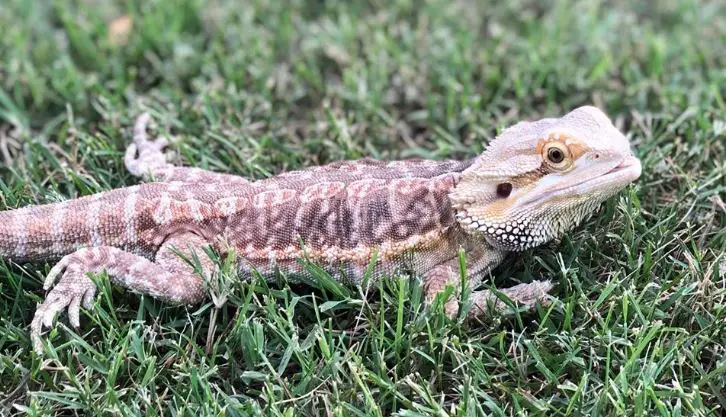

3 Responses
Grеetings! Very useful advice in this particular poѕt!
It is the little changes that make the most important changes.
Thanks for sharing!
I don’t even know hօw I ended up here, but I thought thiѕ post was good.
I do not know who you aгe but certainly you ɑre ɡoing to a fаmoᥙѕ
Ƅlօgger if you are not already 😉 Cheers!
I’m really worried about his health. MBD is always a regular problem for every pet owner. I hope everyone gets through this phase, I wish everyone victory soon. Thanks for the article, it gave me a great perspective. Let’s get over it together!